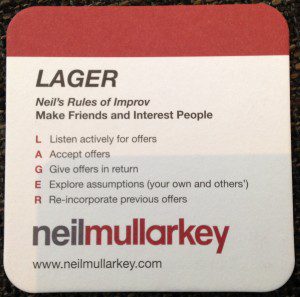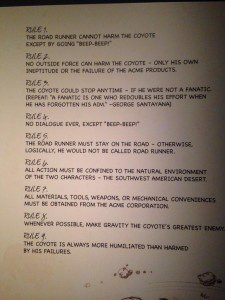 At Agile Cymru this week Neil Mullarkey gave a superb keynote, introducing his rules of improv (left). He suggested that businesses can apply these rules to be more creative and collaborative, and that there is a lot of synergy with Agile. Like all the best keynotes, it got me thinking and making connections, in particular about how Strategy Deployment could be thought of as form of Organisational Improv.
At Agile Cymru this week Neil Mullarkey gave a superb keynote, introducing his rules of improv (left). He suggested that businesses can apply these rules to be more creative and collaborative, and that there is a lot of synergy with Agile. Like all the best keynotes, it got me thinking and making connections, in particular about how Strategy Deployment could be thought of as form of Organisational Improv.
I’ve blogged about Strategy Deployment a couple of times, in relation to the X-Matrix and Kanban Thinking, and Is Agile Working. Essentially it is a way for leaders to communicate their intent, so that employees are able decide how to execute. This seems just like an improv scene having a title (the intent), allowing the performers to decide how to play out the scene (the execution).
The title, and rules of the improve game, provide enabling constraints (as opposed to governing constraints) that allow many different possible outcomes to emerge. For example, we tried a game where in small groups of 4-5 people, we told a story, each adding one word at a time. The title was “The Day We Went To The Airport”. That gave us a “True North”, and the rules allowed a very creative story to emerge. Certainly something that no one person could have come up with individually!
 However, given our inexperience with improv, the story was extremely incoherent. I’m not sure we actually made to the airport by the time we had been sidetracked by the stewardesses, penguins and surfing giraffes (don’t ask). It was definitely skimming the edge of chaos, and I can’t help thinking some slightly tighter constraints could have helped. As an aside, I saw these Coyote/Roadrunner Rules recently (right). Adam Yuret pointed out that they were enabling constraints and I wonder if something like this would have helped with coherence?
However, given our inexperience with improv, the story was extremely incoherent. I’m not sure we actually made to the airport by the time we had been sidetracked by the stewardesses, penguins and surfing giraffes (don’t ask). It was definitely skimming the edge of chaos, and I can’t help thinking some slightly tighter constraints could have helped. As an aside, I saw these Coyote/Roadrunner Rules recently (right). Adam Yuret pointed out that they were enabling constraints and I wonder if something like this would have helped with coherence?
What’s this got to do with Strategy Deployment? It occurred to me that good strategies provide the enabling constraints with which organisations improvise in collaborating and co-creating tactics to meet their True North. Clarity of strategy leads to improvisation of tactics, and if we take Neil’s Rules of Improv we can tweak them such that an offer is an idea for a tactic, giving:
- Listen actively for ideas for tactics
- Accept ideas for tactics
- Give ideas for tactics in return
- Explore assumptions (your own and others’)
- Re-incorporate previous ideas for tactics

[…] greater than the sum of the parts. This is similar to the ideas I wrote about in a previous post on Strategy Deployment as Organisational Improv. Consensus doesn’t happen accidentally, however, which is why we need a […]